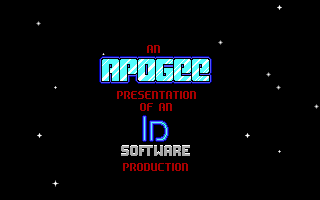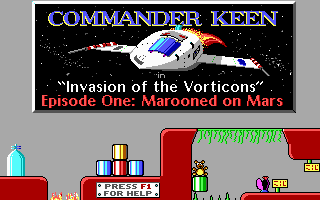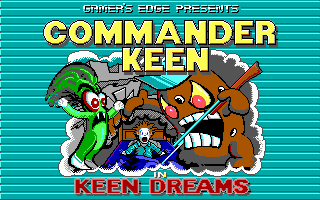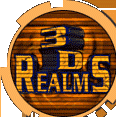






|
 |
A
Look Back at Commander Keen |
 |
 |
 |
 10 years ago, a group of programmers and
artists working at Softdisk created a piece of software that laid the
foundation for just about every popular computer game today.
Working for a company that didn't want to make use of the program that
they created, these guys instead turned to shareware pioneer Scott
Miller to publish their first game. The company is id Software,
and the game is Commander Keen! 10 years ago, a group of programmers and
artists working at Softdisk created a piece of software that laid the
foundation for just about every popular computer game today.
Working for a company that didn't want to make use of the program that
they created, these guys instead turned to shareware pioneer Scott
Miller to publish their first game. The company is id Software,
and the game is Commander Keen!
 On
December 14, 1990, a landmark computer game was released.
Episode 1 of Commander Keen came out this day in 1990, and forever
changed PC computing. Commander Keen was id Software's first big
game, and along with the original Duke Nukem (released in 91),
Apogee Software was recognized as the place to go to for hot,
shareware games. Keen (like every other Apogee title) was
released under the (at the time) unheard of concept of giving away
part of your game for free. The entire first episode of Keen was
released to the world as shareware. The idea was that you got a good sense of what it looks like and feels like, and if you liked it,
you paid for it - and obtained the remaining parts of the game. On
December 14, 1990, a landmark computer game was released.
Episode 1 of Commander Keen came out this day in 1990, and forever
changed PC computing. Commander Keen was id Software's first big
game, and along with the original Duke Nukem (released in 91),
Apogee Software was recognized as the place to go to for hot,
shareware games. Keen (like every other Apogee title) was
released under the (at the time) unheard of concept of giving away
part of your game for free. The entire first episode of Keen was
released to the world as shareware. The idea was that you got a good sense of what it looks like and feels like, and if you liked it,
you paid for it - and obtained the remaining parts of the game.
Commander
Keen - a landmark game. This article tells the story of
Commander Keen - how it was made, what the people behind it felt, and
some things you may never have known before about the game. So
put on your football helmet, grab your pogo stick, and help fight off
Mortimer McMire by becoming Commander Keen - Defender of the
Universe!!
|
|
 |
 |
 |
 |
The
Early Days |
 |
 |
 |
 In
September of 1987, Tom Hall (this picture is legendary) moved from
Wisconsin to Shreveport to take a job programming games at
Softdisk. Tom's games back then were for Softdisk's monthly
subscriptions which included such awesome titles as "Duck Boop". In March of 1989, John Romero joined Softdisk and
made Tom's acquaintance. John started working on programs for
Softdisk's IBM PC line. In
September of 1987, Tom Hall (this picture is legendary) moved from
Wisconsin to Shreveport to take a job programming games at
Softdisk. Tom's games back then were for Softdisk's monthly
subscriptions which included such awesome titles as "Duck Boop". In March of 1989, John Romero joined Softdisk and
made Tom's acquaintance. John started working on programs for
Softdisk's IBM PC line.
Romero's
games soon attracted the attention of a free-lance programmer in
Kansas City, John Carmack, who had been working in a pizza parlor and
programming on the side. Carmack's programs impressed Softdisk
enough that he too made the trek to Shreveport to work for
Softdisk. The two Johns started working together, and it wasn't
long before Tom started sneaking in at night to work with them because
Softdisk management would not allow them to collaborate openly.
Then,
the first breakthrough. John Carmack devised a smooth, scrolling
routine similar to that used for the background of Nintendo games but
never before possible on the PC. When Tom Hall saw the scrolling
in action, his first thoughts were to pull a prank on Romero. In
the course of one night, Hall and Carmack reproduced the first level
of Super Mario 3, pixel by pixel, replacing Mario with a character of
their own named Dangerous Dave. They finished the work around
5AM, calling it "Dangerous Dave in Copyright
Infringement". Tom & John put the disk on Romero's
desk, and left to get some sleep. John Romero arrived at
Softdisk that day, booted up the game, and did not stop to take a
breath until three hours later. More than a prank, Romero saw
the staggering commercial potential of Carmack's design.
 There
was also at Softdisk a project manager named Jay Wilbur. Romero
approached Jay with a new Super Mario demo. Allured by the same
visions of limitless wealth, Jay approached Nintendo. It is rumored
that id's Mario demo (shown here) made it to the highest levels of
Nintendo, but this has never actually been confirmed over the
years. However, Nintendo declined the idea deciding that Mario
wasn't for the PC, it was a console only title. In the end, the
Softdisk guys decided to pursue the game on their own - in secret, of course, as
they weren't supposed to be working together in the first place at
Softdisk.
Why? Who knows now? There
was also at Softdisk a project manager named Jay Wilbur. Romero
approached Jay with a new Super Mario demo. Allured by the same
visions of limitless wealth, Jay approached Nintendo. It is rumored
that id's Mario demo (shown here) made it to the highest levels of
Nintendo, but this has never actually been confirmed over the
years. However, Nintendo declined the idea deciding that Mario
wasn't for the PC, it was a console only title. In the end, the
Softdisk guys decided to pursue the game on their own - in secret, of course, as
they weren't supposed to be working together in the first place at
Softdisk.
Why? Who knows now?
Tom
Hall remembers... "Softdisk didn't want to use the smooth scrolling trick Carmack
had discovered (since it didn't also work in CGA), so we thought, well, if they don't
want it, we could do something ourselves...
So we thought, hey, we'll make our own game. We needed a topic. I
asked if they cared what topic - sci-fi, fantasy, whatever. I think
Carmack mentioned a kid that saves the galaxy or something. I went
off and fifteen minutes later, came back with the paragraph that you
see in Keen 1. I read it in a Walter Winchell voice (he's a nasal
40s radio/newsreel announcer). Carmack clapped after I was finished,
and we were off and running."
The
paragraph of text that Tom refers to is the text that appears at the
beginning of Keen 1:
Billy Blaze, eight year-old genius, working diligently in his backyard clubhouse has created an interstellar starship from old soup cans, rubber cement and plastic tubing. While his folks are out on the town and the babysitter has fallen asleep, Billy travels into his backyard workshop, dons his brother's football helmet, and transforms into...
COMMANDER KEEN--defender of Earth!
In his ship, the Bean-with-Bacon Megarocket, Keen dispenses galactic justice with an iron hand!
Meanwhile,
a series of peculiar fan letters had been arriving at Softdisk,
praising John Romero's games. At first, seeming to represent the
ravings of a wide number of Softdisk fans, Romero eventually
determined that all the letters came from the same address in Garland,
TX. Discovering the fraud, Romero fired off a threatening
letter, and in this manner made contact with id's first
benefactor. Scott Miller, anonymous author of the many letters,
was a founder of Apogee Software, a pioneer in the shareware approach
to marketing computer games. Miller told Romero that he loved the
Softdisk games and wanted to lure them into the shareware
market. Romero sent Miller a game called Catacombs, which
whetted Miller's appetite. But once he got a glimpse of the
Super Mario demo for the PC that Carmack & Romero had done, he
offered to put up some money to finance their first real game.
Hall, Romero, & Carmack asked for $2,000 to get their game off the
ground. Miller had $5,000 in his bank account - he promptly sent
them a check for 2/5 of that.
For
three months, the trio programmed for Softdisk during the day, and
slaved away on "Commander Keen: Invasion of the Vorticons" in
every free moment. However, they needed some more folks to help
complete the game, so they set out to recruit some new blood. They
had long admired the artistry of an intern at Softdisk, Adrian Carmack
(no relation). They invited Adrian to join them and finished
Commander Keen with significant improvements to the look of the final
levels.
Adrian
Carmack remembers his initial involvement in Commander Keen:
"Hmm...well
as I recall I drew and animated one of the characters. I don't
recall the name off hand. I think he was some sort of a Ninja type
of character. I created some teleport windows, a few awful
illustrations, etc. Ugh..bad memories. I had just started creating
computer art, so it was definitely not some of my better work. Plus
I wasn't a cartoonist. I had quite a learning curve on the Keen
series. My work on the later Keens was much improved."
|
|
 |
 |
 |
 |
Keen
is Released |
 |
 |
 |
The initial team was now
complete.
 With
this, Apogee released the
first episode of Commander Keen on December 14, 1990. Gamers
who wanted the next two levels had to pay for them - and pay they
did. In January, the id guys got their first royalty check, for
approximately $10,000. The two Johns went to lunch with the
owner of Softdisk, told him they were leaving, and also informed him
that Adrian was coming with them. They then returned to the
office and informed Adrian that they had arranged for his
resignation. As the entire design team was leaving, Adrian
thought it was wise to comply. id Software was officially formed
on Feb 1, 1991. With the release of Commander Keen, id Software
& Apogee had a huge hit on their hands - the two companies getting
a lot of great press over the landmark title for the PC. Joe
Siegler remembers the relationship of the two companies.... With
this, Apogee released the
first episode of Commander Keen on December 14, 1990. Gamers
who wanted the next two levels had to pay for them - and pay they
did. In January, the id guys got their first royalty check, for
approximately $10,000. The two Johns went to lunch with the
owner of Softdisk, told him they were leaving, and also informed him
that Adrian was coming with them. They then returned to the
office and informed Adrian that they had arranged for his
resignation. As the entire design team was leaving, Adrian
thought it was wise to comply. id Software was officially formed
on Feb 1, 1991. With the release of Commander Keen, id Software
& Apogee had a huge hit on their hands - the two companies getting
a lot of great press over the landmark title for the PC. Joe
Siegler remembers the relationship of the two companies....
"Because
of the close relationship of the companies at this time, most people
(mistakenly) assumed that Apogee was id, or Apogee "owned"
id or something of this nature. Far from it. Apogee
& id were always separate companies. That error continued
for a long time, especially after Wolfenstein 3D was released in the
same manner. During the early days of Doom's development, id
was going to release Doom through Apogee as well. This
confusion even continued into id's Quake era, as we still occasionally
get a customer asking "Hey, Quake is a 3D Realms game,
right?"
 The
group still had obligations to Softdisk, which they worked to fulfill
even as they established id. Several other titles were produced
for Softdisk during this time, in addition to concept work on further
Commander Keen episodes. During this time, one of the titles
produced for Softdisk was called "Keen Dreams". Keen
Dreams is often referred by folks as the "lost episode" of
Keen. Some others (including myself) refer to it as "Keen
3.5". The reason for this is that in terms of technology as
well as the time that the game was produced, it falls in between the
Vorticons series and the Galaxy series (Episodes 4-5). Tom Hall
remembers the Keen Dreams project.. The
group still had obligations to Softdisk, which they worked to fulfill
even as they established id. Several other titles were produced
for Softdisk during this time, in addition to concept work on further
Commander Keen episodes. During this time, one of the titles
produced for Softdisk was called "Keen Dreams". Keen
Dreams is often referred by folks as the "lost episode" of
Keen. Some others (including myself) refer to it as "Keen
3.5". The reason for this is that in terms of technology as
well as the time that the game was produced, it falls in between the
Vorticons series and the Galaxy series (Episodes 4-5). Tom Hall
remembers the Keen Dreams project..
"As
part of leaving, we agreed to do games so the Gamer's Edge product
could continue. At the time, I really didn't want to do a Keen for
them, but we needed a ramp-up for the next Keen trilogy. I was
eventually convinced. We were doing this game and some other game at
the same time. It was kinda crazy. But doing all those different
types of games (puzzle, shooter, platform, and so on) was incredible
training. You'd have to work for a decade on normal-sized games to
get that experience. We did it in a year."
 1991
was a crazy year for id and Keen. In January of 1991, they
finished the final update to Keen Vorticons, and then worked on the
aforementioned Softdisk titles. The guys moved from Shreveport
to Madison, Wisconsin in September of 1991 - got shocked at how cold
it was (even though Tom was from there), yet still managed to work on
games up there for six months (they moved back to Dallas on April 1,
92). Anyway, it was during this time in Madison that work began
on more Keen games... 1991
was a crazy year for id and Keen. In January of 1991, they
finished the final update to Keen Vorticons, and then worked on the
aforementioned Softdisk titles. The guys moved from Shreveport
to Madison, Wisconsin in September of 1991 - got shocked at how cold
it was (even though Tom was from there), yet still managed to work on
games up there for six months (they moved back to Dallas on April 1,
92). Anyway, it was during this time in Madison that work began
on more Keen games...
[
NEXT PAGE - A Keen sequel & the
future ]
|
|
 |
 |
 |
|

 |













